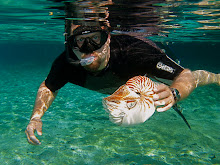 |
| Vibrant reefs to explore |
Well this past November
Oceanic Society returned to
Raja Ampat for our second snorkeling expedition. This year we were joined by 16 avid snorkelers. Many had already visited a dynamic array of snorkeling destinations including Tonga,
Micronesia, Palau, and Fiji. Our trip has now switched to a new vessel, the SeaSafari 8, much larger and outfitted (for our group) for limited diving. Our itinerary had us departing from Sorong and heading towards
Misool for our first evening, after that we would head back up North and visit a variety of locations that had been highlights from
last years trip.
 |
| Our vessel - SeaSafari 8 |
As we left Sorong we were excited and eager to finally get in the water. Even though all of us have been around the globe snorkeling, there is really nothing like
Raja Ampat. This bastion of marine biodiversity does not disappoint. For shear numbers of species and visible variety of macrolife it is unparalleled. Each time you enter the water you can be assured that you will almost certainly see something you have never seen before, no matter your level of experiences. Add to this the physical beauty of the islands, the warm water, and the fact that you rarely share any of the sites with another person and you have set yourself up for a true escape into nature. One where you can spend as much time as you want exploring and observing the kaleidoscope of diversity that is on display. As you float through these vibrant coral reefs you see an ecological landscape that is as dynamic as the Serengeti. Animals are competing for resources and access to mates, some creatures are
preforming services for others in exchange for something that benefits them, a mutualistic relationship. It is easy to forget as you float over all these strange animal lifeforms that they are indeed just that, a resilient and interlinked ecosystem of species, each with their own unique strategy for survival. To follow are just a few of the amazing sightings we had in 2012.
 |
| Peacock Mantis Shrimp |
 |
| Ghost Pipefish |
 |
| Blue-Girdled Angelfish |
 |
| Our local guide Dalton photographing a Lionfish |
 |
| Tasselled Wobbegong Shark |
 |
| Glorious Flatworm |
 |
| Map Puffer | |
|
|
|
 |
| Social Tunicates |
 |
| Juvenile Regal Angelfish |
These photos show just a small sample of the amazing critters we saw on our adventure. With one of the world's richest coral reef fish fauna, over 1300 species, and harboring over 75% of the world's coral species, every moment in the water was special. During out trip we also were able to have a few land based activities. The primary one being a return visit to the village of Sawinggrai on Gam Island. Here we had the opportunity to view the
Red Bird-of-paradise (
Paradisaea rubra) at a
lek site. Just like the previous year, after about 20 minutes of waiting we were rewarded with great views of the males preforming mating displays. As we turned to leave we had another surprise, an arboreal mammal had been watching us as we admired the birds. A few branches away was the
Spotted Cuscus (
Spilocuscus maculatus), a truly strange looking creature, seemingly a bit of a cross between a possum and a lemur! On our way back from the bird hike we saw many different species of orchids which the villagers had placed along the trail. We also saw a few more bird species including parrots and fruit doves.
 |
| Red Bird-of-Paradise |
 |
| Spotted Cuscus |
 |
| Parrot species |
What another incredible snorkeling expedition to Raja Ampat. Many of our group went on for 5 more days of snorkeling in Sulawesi and I will post some photos from that extension soon. Inspired by all that we saw this season we are already beginning to plan our 2013 return, these trips fill up quickly so please visit Oceanic Society's
trip webpage for more information about how you can participate.
























































